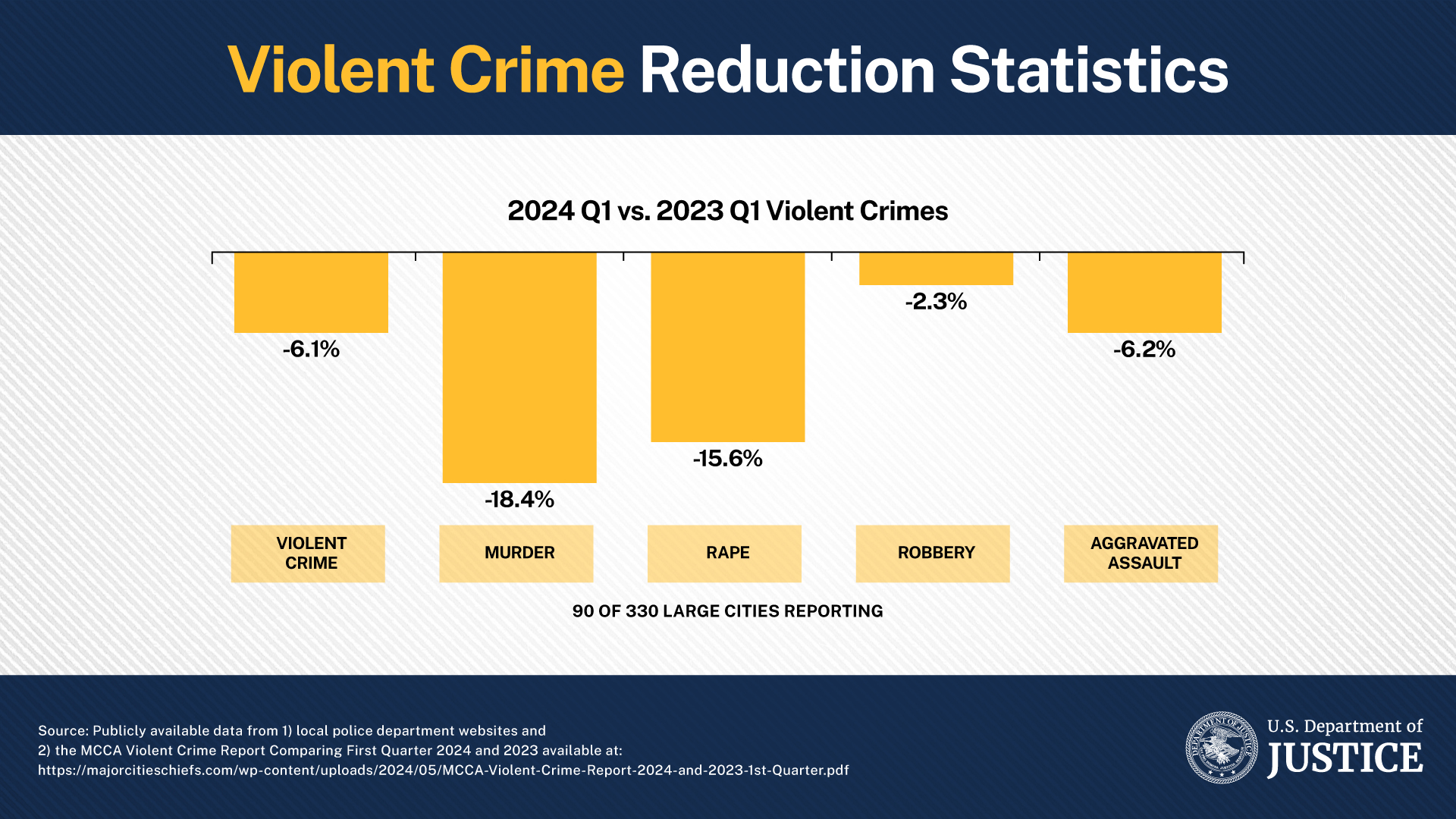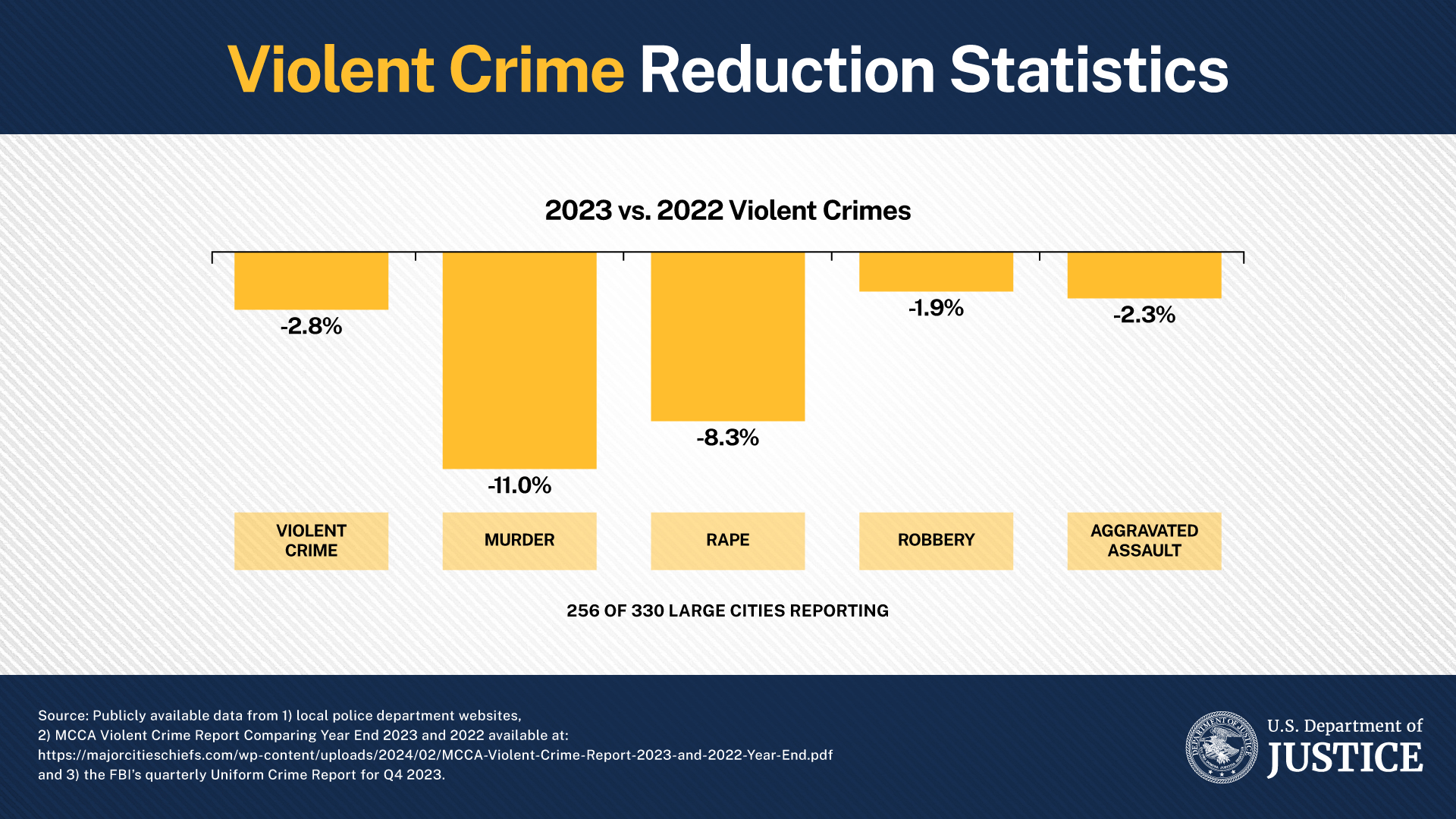Press Release
Readout of the Justice Department’s Violent Crime Reduction Steering Committee Meeting
For Immediate Release
Office of Public Affairs
The Justice Department’s Violent Crime Reduction Steering Committee met today to address recent advances in combating violent crime and plans for building on those advances. Over the last few years, Attorney General Merrick B. Garland has increased resources and established violent crime initiatives across the country in order to bring down violent crime. In addition, Deputy Attorney General Lisa Monaco announced the Department’s Comprehensive Strategy for Reducing Violent Crime, which created a Steering Committee chaired by Principal Associate Deputy Attorney General (PADAG) Marshall Miller and composed of leadership and representatives from across the Justice Department, including law enforcement, prosecutorial, and grantmaking components, to plan and assess initiatives, ensure coordination, and form recommendations for Department leadership in the fight to reduce violent crime.
After PADAG Miller called the meeting to order, the Committee was briefed on the latest violent-crime statistics, which show a notable and steady decline in violent crime. From calendar year 2022 to calendar year 2023, data[1] from over 250 cities showed that violent crime declined considerably, including an 11% decrease in murder, an almost 8.5% decrease in rapes, a 2.3% decrease in aggravated assault, and a nearly 2% decrease in robbery.
Early data[2] from the first quarter of 2024 indicates continuing declines in each of these categories — a 18.4% decline in murder, a 15.6% drop in rape, a 6.2% decrease in aggravated assault, and a 2.3% decline in robbery.
The Committee received updates from the Department’s law enforcement components on progress implementing priority Justice Department violent crime initiatives. The ATF discussed the continued expansion and utilization of Crime Gun Intelligence Centers (CGICs) to combat violent crime. CGICs use cutting-edge technology to rapidly develop and pursue investigative leads, by analyzing firearm and ballistics evidence. The FBI highlighted the work of carjacking task forces — a strategic Department enforcement priority that focuses federal resources on identifying, investigating, and prosecuting the worst carjacking offenders. Carjacking task forces bring together ATF and FBI agents, Justice Department prosecutors, and state, local, Tribal, and territorial law enforcement officers and are now operating in 11 districts across the country.
The Committee was also briefed on recent successes of the Criminal Division’s Violent Crime Initiative (VCI), which works with U.S. Attorneys’ Offices and federal law enforcement in Hartford, Houston; Jackson, St. Louis, and Memphis, and surged resources to Washington, D.C. The briefing highlighted VCI achievements in Houston, where Criminal Division prosecutors and Assistant U.S. Attorneys have surged enforcement and community outreach efforts and use data to focus on the most prolific offenders and recidivists responsible for violence. Since the launch of the Houston effort, the city has seen a 9% reduction in violent crime and a 20% decline in homicides.
The U.S. Attorney community presented on fruitful strategies in combating violent crime around the country. U.S. Attorney Dawn Ison for the Eastern District of Michigan discussed the One Detroit initiative — a program that brings together law enforcement and community stakeholders to develop and implement a comprehensive violence reduction strategy, combining enforcement, violence prevention and intervention resources, and reentry programs. Violent crime rates in Detroit have fallen dramatically, with the city closing out 2023 with the fewest homicides on record in over 50 years. U.S. Attorney Andrew Luger for the District of Minnesota updated the Committee on the successes in his district in cracking down on violent crime, especially during the summer months when violent crime historically surges. U.S. Attorney Luger also shared best practices in fighting summer violent crime surges from around the country, including from the U.S. Attorney’s Office for the District of Connecticut.
The Steering Committee also heard from additional components regarding plans, resources, and best practices to combat violent crime. Specifically, DEA representatives discussed the Tenderloin Project — a joint effort involving federal, state, and local law enforcement partners addressing fentanyl poisonings and drug-related violence in the Tenderloin neighborhood of San Francisco. U.S. Marshals Service representatives described the next phase of its Operation North Star, which utilizes data-driven approaches and surges of law enforcement resources to target the most dangerous armed violent fugitives in selected cities.
U.S. Attorney Alison Ramsdell for the District of South Dakota then described the need for further federal assistance in combating violent crime in Indian country. The Committee endorsed the launch of an inter-component effort to align the necessary personnel and resources to increase significantly federal support for public safety in Indian country.
At the conclusion of the meeting, Principal Associate Deputy Attorney General Miller indicated that the Steering Committee would report to Department leadership on developments from the Department’s violent crime reduction initiatives and provide recommendations regarding additional policy and enforcement strategies.
[1] Major Cities Chiefs Association Violent Crime Survey Year End Comparison, available at https://majorcitieschiefs.com/wp-content/uploads/2024/02/MCCA-Violent-Crime-Report-2023-and-2022-Year-End.pdf; FBI’s Quarterly Uniform Crime Reports, available at: https://cde.ucr.cjis.gov/LATEST/webapp/#/pages/explorer/crime/quarterly.
[2] This data, from 90 cities, is subject to change as more entities provide data and reporting is finalized.
Updated February 6, 2025
Topic
Violent Crime
Components

 U.S. Department
of Justice
U.S. Department
of Justice







